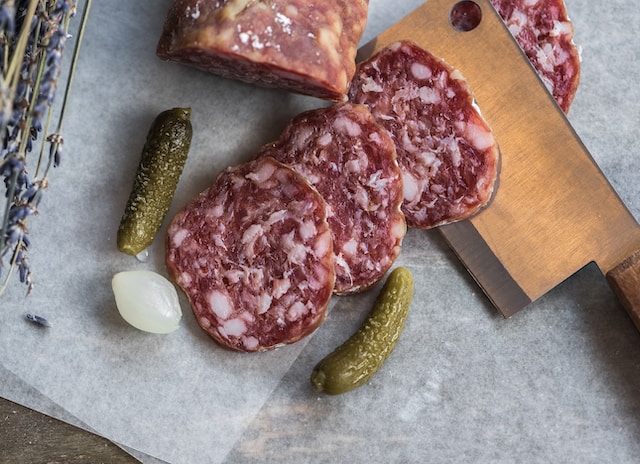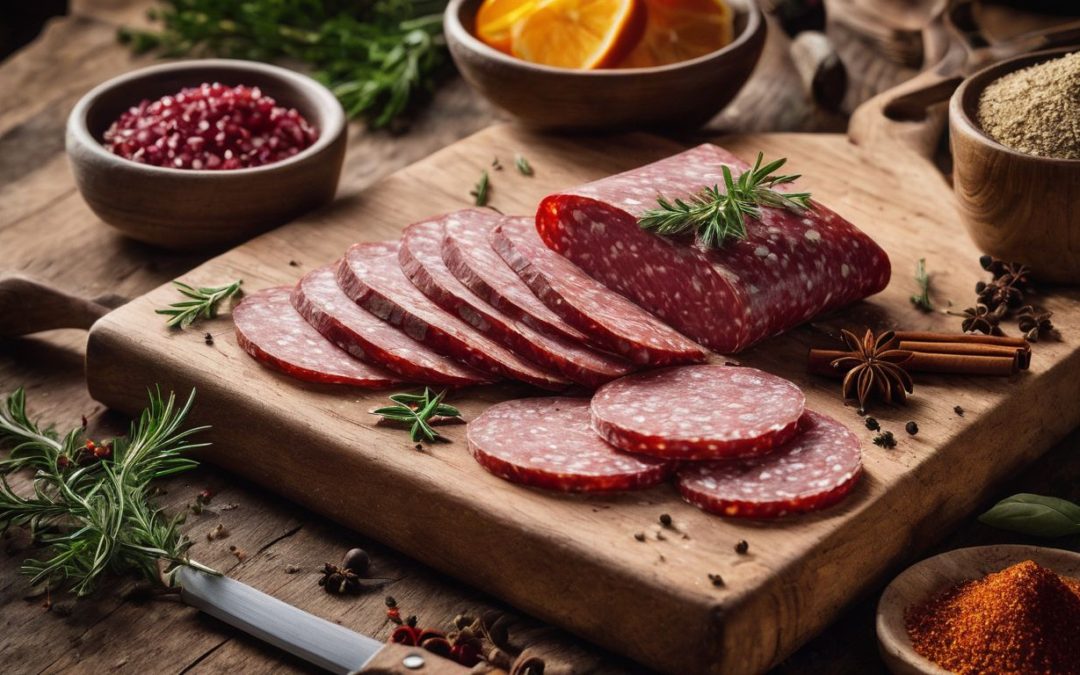Ever found yourself pondering over the tale behind that enticing slice of salami on your charcuterie board? It seemed to me, as I savored each bite, there was more to its deliciousness than met the taste buds.
So, driven by this curiosity and my insatiable love for food stories, I delved into a detailed research journey. The outcome is an intriguing account of salami – from its humble beginnings to becoming a favorite in different flavors and varieties across the globe today.
Ready for a flavor-filled ride through history? Let’s dive in!
The Origins of Salami

The history of salami traces back to the ancient practice of preserving meats through curing, which involved using salt and cold smoking to dry the meat and extend its shelf life.
History of Preserving Meats
Long ago, people had to find ways of keeping meat fresh. They could not let it go bad. So they used salt, smoke and dry air. Salt takes water away from the meat which stops bacteria that cause food to spoil.
Smoke also helps kill these tiny bugs and gives flavor too! Cool, dry air pulls out more water slowing down bacteria growth even further! This way of preserving meats helped folks have good food year round long before fridges were a thing!
Importance of Salt in Meat Curing
Salt plays a big role in curing meat. It helps to keep the meat safe as it cures. This is because salt stops bad things from growing on the meat, like bugs and mold. It does this by taking water out of the meat.
When there’s less water, bad things find it hard to grow.
Besides safety, salt also gives flavor to the cured meats such as salami. It brings out and heightens the taste of other spices used in curing process. So not only does salt protect our favorite types of salami but it gives them their tasty and zingy flavor too!
Cold Smoking to Dry Meat & Preserve
Cold smoking is an age-old trick people used to keep meat good for a long time. They let thin smoke go over the meat. This made the meat dry out and helped stop bugs from making it bad.
The smoke also added a nice taste to the cured meats like salami. They often did this in cool places so that the fire’s heat didn’t cook the meat. So, not only did their salami last longer, but it also had that special smoky flavor we all love!
Early Examples of Cured Meats
Cured meats have been around for a really long time. Back in the prehistoric days, when people started breeding and eating pork, they figured out how to preserve meat without refrigeration.
This led to the development of cured meats like salami. These early examples of cured meats were made by fermenting and air-drying the meat, usually pork. The process allowed the meat to be stored for longer periods of time, making it a valuable food source.
It’s amazing to think that this method has been used since ancient times and continues to be enjoyed by meat lovers today!
The Italian Tradition

The Italian tradition of salami dates back centuries, with the development of salumi and classic cured meats. From its etymology to regional variations, there is so much to explore about this iconic Italian delicacy.
Find out more about the rich history of salami in Italy by reading on!
Etymology of Salami
The word “salami” comes from the Italian language. In Italian, “salame” refers to ground meat that is preserved and cured. This delicious cured meat has a long history and is beloved by many.
Salami is usually made from pork or beef, although there are variations made with other types of meat as well. It’s interesting to note that donkey meat has also been used in some salami recipes! The etymology of salami shows us how this tasty treat originated in Italy and became popular all around the world.
Development of Salami in Italy
Salami has a rich history in Italy and is considered a classic cured meat. It originated in Italy and was developed as a way to preserve meat without refrigeration. Salami was particularly popular among the Southern, Eastern, and Central regions of Italy.
The word “salame” specifically refers to ground meat preserved in this way. Salumi, which includes salami, are traditional Italian cured meats that have been enjoyed for centuries.
Today, salami continues to be an important part of Italian cuisine and is loved by meat lovers around the world.
Salumi & Salami – Italian Cured Meat Classics
Salumi and salami are delicious Italian cured meat classics that have been enjoyed for centuries. Salami is a type of cured sausage made from fermented and air-dried meat, usually pork.
It has a marbled appearance and is considered a classic in Italian cuisine. The word “salame” specifically refers to ground meat preserved this way. These meats have been around since prehistoric times when humans started breeding and consuming pork.
They were developed as a way to preserve meat without refrigeration. So if you’re a fan of cured meats, salumi and salami are definitely worth trying!
Spread of Salami
Salami quickly gained popularity beyond Italy, with the Roman Empire playing a significant role in its spread throughout Europe. Even during the Christian era, when pork was prohibited by religious practices, salami continued to be produced using alternative meats such as beef and donkey.
The French also developed their own version of cured meats, known as Charcuterie, which included salami among other delicious offerings.
Roman Empire
During the time of the Roman Empire, salami was already a popular food. The Romans loved their cured meats, and salami was no exception. It was a delicious and convenient way to preserve meat without refrigeration.
Salami would often be enjoyed by soldiers on long journeys or at banquets in Rome. In fact, it became such an important part of Roman cuisine that it spread throughout the empire and beyond.
Even today, we can still see traces of the Roman influence on our beloved salami.
Christians and Salami
Christians also played a role in the history of salami. In ancient Rome, there were certain religious restrictions on eating pork. But as Christianity spread throughout Europe, these restrictions began to relax.
Christians started enjoying this delicious cured meat and it became popular among them. So, even though salami had its origins in preserving meats without refrigeration, it was embraced by Christians and became a part of their cuisine too.
Salami is truly a versatile and beloved cured meat enjoyed by people from different cultures and backgrounds.
Classic French Charcuterie
I love talking about Classic French Charcuterie because it’s a delicious part of the culinary world. Charcuterie is basically the art of preparing and preserving meat, and the French are masters at it.
They have their own unique range of cured meats that are loved around the world. From pâté to rillettes, sausages to terrines, there’s something for everyone to enjoy. The French take great pride in using quality ingredients and traditional techniques to create these savory delights.
So, if you’re a meat lover like me, exploring classic French charcuterie is definitely worth your time.

Ingredients and Manufacturing
Salami is made from a combination of ground meat, typically pork or beef, fat, salt, and various spices and seasonings. The manufacturing process involves grinding the meat, mixing it with the other ingredients to create a raw meat mixture, stuffing it into casings (usually pig intestines), and then allowing it to ferment and air-dry over time.
Ingredients Used in Salami
Salami is made using a simple recipe with just a few key ingredients. The main ingredient in salami is meat, usually pork or beef. High-quality cuts of meat are used to ensure that the salami has a delicious taste and texture.
To give the salami its distinct flavor, spices and seasonings are added to the meat mixture. These can include garlic, black pepper, paprika, fennel seeds, and other herbs and spices.
Salt is also an important ingredient as it helps preserve the meat during the curing process.
In addition to these basic ingredients, some varieties of salami may include additional flavors such as wine or cheese. However, traditional salamis stick to the classic combination of high-quality meat and flavorful spices.
It’s this simplicity that allows the true essence of the cured meat to shine through in each bite.
The manufacturing process for making salami involves grinding the meat and mixing it with all these ingredients until well combined. The mixture is then stuffed into casings made from pig intestines or artificial materials like collagen or cellulose casings.
Once filled, the sausages are left to ferment and dry over a period of several weeks or even months depending on the variety.
Manufacturing Process of Salami
To make salami, the first step is to select high-quality pork or beef. The meat is then ground and mixed with spices and seasonings like salt, pepper, garlic, and sometimes wine. This mixture is stuffed into casings made from pig intestines or synthetic material.
After that, the sausages are hung in a controlled environment for fermentation and drying. During this time, natural bacteria break down proteins in the meat, creating unique flavors.
The salami will continue to dry until it reaches its desired texture and flavor profile. Finally, it is ready to be sliced and enjoyed!
Varieties of Salami
There are numerous regional variations of salami, each with its own unique flavors and ingredients. From the spicy Calabrese salami to the savory Genoa salami, there is a type of salami to suit every palate.
Regional Variations
Salami has different regional variations that add unique flavors and ingredients to this classic cured meat. In Italy, for example, there are various types of salami from different regions such as Calabrese, Milano, and Napoli.
Each region has its own traditional way of making salami, using their preferred spices and seasoning. Similarly, other countries have their own versions of salami with distinct characteristics.
For instance, Hungary is famous for its Hungarian Salami, which is known for its rich flavor and spicy kick. Exploring these regional variations allows us to discover the diverse flavors and techniques used in making this delicious cured meat.
Different Flavors and Ingredients
Salami is versatile and rich, with an array of flavors and ingredients that vary from region to region. Let’s dive into the world of salami, exploring the variety of flavors and ingredients that make each type unique.
| Type of Salami | Main Ingredients | Flavor Profile |
|---|---|---|
| Genoa Salami | Pork, beef, wine, garlic | Rich, tangy, with a hint of garlic and wine |
| Milanese Salami | Pork, beef, wine, garlic, pepper | Smooth, mildly spicy, with the sweetness of wine |
| Pepperoni | Beef, pork, paprika, chili pepper | Spicy, smoky, with a hint of paprika and chili |
| Hungarian Salami | Pork, bacon, garlic, white pepper, coriander, allspice | Rich, spicy, with a distinct flavor of garlic and spices |
| Felino Salami | Pork, wine, sea salt, black pepper | Sweet and salty, with a taste of wine and pepper |
| Finocchiona | Pork, fennel seeds, red wine, garlic | Aromatic, with a sweet and slightly spicy taste from the fennel seeds |
As you can see, different types of salami use diverse ingredients to achieve unique flavor profiles. The next time you enjoy a slice of salami, remember the rich history and craft that went into creating that delicious bite!
Properties and Shelf Life of Salami
Salami has distinct characteristics, such as its rich flavor, intense aroma, and a dense texture that is both chewy and tender. It is known for its long shelf life due to the curing process, allowing it to be stored without refrigeration for extended periods.
Characteristics of Salami
Salami has some distinct characteristics that make it a unique and delicious cured meat. It is typically made from pork or beef, and it has a marbled appearance due to the fat distributed throughout the meat.
Salami is fermented and air-dried, giving it a rich and intense flavor. This curing process also gives salami its characteristic tangy taste. The casing of salami is usually made from pig intestines, which helps preserve the meat during the drying process.
Salami can be enjoyed on its own as a snack or used in various dishes to add flavor and texture. Whether you like it sliced thin or thick, salami is sure to satisfy any meat lover’s cravings!
Shelf Life and Storage
Salami has a good shelf life because it is a cured meat. When stored properly, it can last for several weeks or even months! All you need to do is keep it in a cool and dry place, like your pantry.
Remember, refrigeration is not necessary for salami. Additionally, it’s important to store salami in a way that allows air circulation to prevent moisture buildup. You can wrap the salami in wax paper or butcher paper, and then put it in a breathable bag or container.
This will help maintain its quality and flavor for longer. Just make sure to check the expiration date before enjoying your delicious salami!
Cultural Significance
Salami holds a significant place in Italian cuisine, being used in various dishes like sandwiches, antipasti platters, and pasta sauces. It is also celebrated during traditional festivals and gatherings where it is sliced thin and enjoyed with other cured meats and cheeses.
Additionally, salami has gained popularity beyond Italy, finding its way into cuisines around the world as a versatile ingredient that adds depth of flavor to many dishes.
Salami in Italian Cuisine
Salami is considered a classic cured meat in Italian cuisine. It has been enjoyed by Italians for centuries and is an integral part of their culinary tradition. Salami is made from high-quality beef or pork, seasoned with spices, and cured to perfection.
It adds a rich and savory flavor to dishes like pasta, pizza, sandwiches, and antipasti platters. Whether sliced thin or chunky, salami brings its unique taste and texture to every bite.
Its versatility makes it a popular choice in Italian cooking, adding depth and complexity to various recipes. So next time you indulge in Italian cuisine, don’t forget to savor the deliciousness of salami!
Salami in Other Cuisines
Salami is not just popular in Italian cuisine, it can also be found in other cuisines around the world. Different countries have their own versions of salami that use unique flavors and ingredients.
For example, in Spain, there is a type of salami called chorizo that is made with pork and seasoned with paprika. In Germany, they have a variety called landjäger which is air-dried and often eaten as a snack.
Even in China, you can find a type of cured sausage known as lap cheong that is made from pork and seasoned with soy sauce and spices. So whether you’re enjoying an antipasto platter or exploring new flavors abroad, salami has truly become a global favorite for meat lovers everywhere!
Health Effects of Salami
Salami is a delicious and popular cured meat, but it’s important to be aware of the health effects associated with consuming it.
Nutritional Content
Let’s take a delectable dive into the nutritional content of salami, every meat lover’s delight. The table below provides a summary of what you can expect in terms of nutrition from a 100g serving of this classic cured meat.
| Nutrient | Amount |
|---|---|
| Calories | 336 |
| Protein | 20.6g |
| Fat | 27.7g |
| Carbohydrates | 1.5g |
| Sugars | 0.5g |
| Fiber | 0g |
| Cholesterol | 69mg |
| Sodium | 1474mg |
As you can see, salami is a good source of protein, which is essential for building and repairing tissues. However, it’s also high in fat, particularly saturated fat, and salt. It’s definitely a meat to enjoy in moderation!
Safety Concerns
As a meat lover, it’s important to be aware of the safety concerns when it comes to salami. While salami is a delicious and popular cured meat, there are some things you should keep in mind.
One concern is the use of nitrates or nitrites in the curing process. These additives can help prevent bacterial growth and preserve the meat, but excessive consumption may have health risks.
It’s also crucial to ensure that high-quality meats are used in making salami, as poor quality or mishandled meats can increase the risk of foodborne illnesses. Additionally, proper storage and handling of salami are essential to prevent spoilage and contamination.
Conclusion.
Salami has a rich history that dates back to ancient times. It originated in Italy and quickly spread throughout Europe, becoming a beloved cured meat. With its unique flavor and long shelf life, salami has become a staple in Italian cuisine and is enjoyed by meat lovers around the world.
So next time you bite into a slice of delicious salami, remember the centuries-old traditions and techniques that have made it a classic cured meat.
FAQs
1. What is the history of salami?
Salami, a cured meat made from pork and beef, has its roots in northern Italy. It has been a popular meat product for centuries because it helped keep fresh meat supplies.
2. Are there different types of salami?
Yes, there are many types of cured meats like Italian salami and sausages. They come in variety including beef or pork meat based, halal and kosher salami.
3. How does making of Salami work?
The making process involves grinding up the type of meat used to make salami, followed by fermentation or direct acidification which makes the uncooked meat safe.
4. Is there a unique look for Salamis?
Yes! A typical marbled appearance comes out when fat in the mix hangs with salted meats during curing giving each particular salami variety its charm.
5. Does region influence taste and type of Salamis?
Absolutely! For example, goose salami hails from Northern Italy while donkey meat is used elsewhere ensuring regional flavors shine through.
6.What’s special about dry-cured Salamis?
Dry cured process lets organisms grow in food to prevent spoilage during curing resulting in fully cured prosciutto-style salonies that can be enjoyed as such!
Greetings!
With over two decades of diverse experience in the meat industry, I proudly stand as an expert in all things meat. My journey commenced with a strong foundation in hospitality, where I honed my culinary skills as a chef in prestigious restaurants and on luxurious superyachts worldwide.
However, my true passion lies in the art of butchery. Throughout my extensive career, I have had the privilege of working with renowned meat purveyors and mastering the craft of meat cutting and preparation. From breaking down whole carcasses to meticulously selecting prime cuts, my butchery expertise is at the core of my meat knowledge.
Having immersed myself in various cultures and cuisines, I have honed my skills to deliver exceptional dining experiences, crafting delectable dishes that celebrate the natural flavors of different meats. Whether it’s sourcing the finest meats for discerning clients or sharing valuable tips on meat selection and cooking, I take pride in elevating the meat experience for both professionals and enthusiasts.
My journey has taken me from the bustling kitchens of top-rated restaurants to the heart of meat processing facilities, gaining insights and honing my skills to become a true meat connoisseur. Now, I am enthusiastic about sharing my expertise, offering valuable insights on meat selection, cooking techniques, and the art of butchery.
















